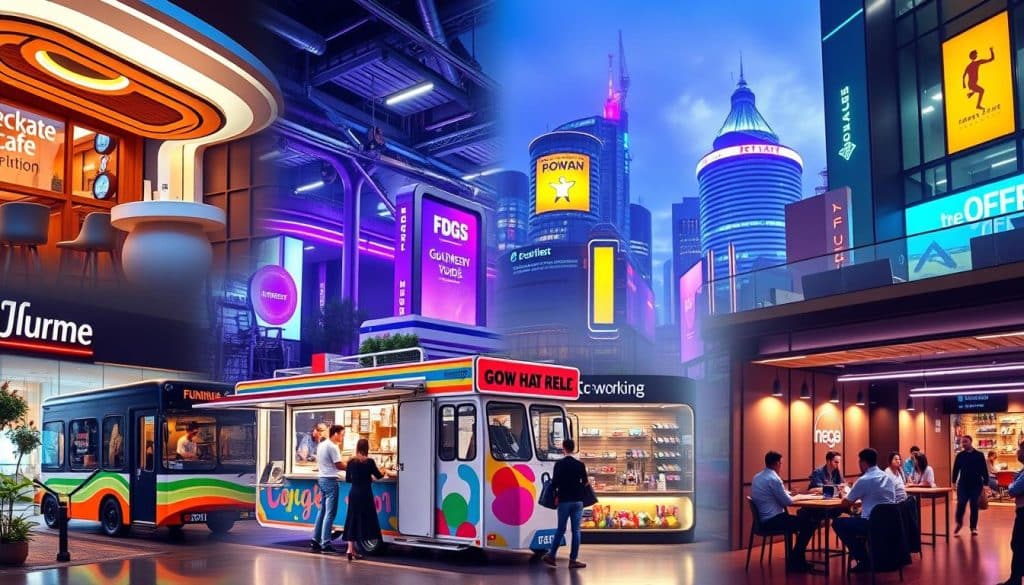Ever curious about the top franchise brands that rule the global scene? What makes them stand out? The biggest franchises in the world are known for their huge revenue, strong brand, and wide reach. This article explores their success and the strategies behind it.
From giants like McDonald’s and Starbucks to new players, we’ll uncover what it takes to be a leader. You’ll also get a peek into the trends that are shaping the future of franchising.
Key Takeaways
- The Pokémon franchise leads with a staggering revenue of $98.9 billion.
- Franchise rankings are determined by a thorough check of over 150 data points.
- Big names like Taco Bell and Dunkin’ are changing the fast-food game.
- Keeping a strong revenue and brand image is key for a franchise’s success.
- Newcomers like Tropical Smoothie Cafe are making waves with fresh ideas.
Introduction to Global Franchises
Franchising is a growing way to share goods and services worldwide. It’s a deal where a franchisee pays a fee to use a brand and system from a franchisor. This partnership has helped many businesses grow, thanks to strong brands and support.
Definition of Franchising
There are two main types of franchising: business format franchising and product distribution franchise. Business format franchising, seen in fast food, gives a full business plan. It includes branding, marketing, and how to run the business. This shows how important brand trust is to customers.
On the other hand, product distribution franchises focus on selling specific products. You can find them in car and gas industries. This variety shows franchising can work in many ways.
Historical Overview of Franchising
The idea of franchising started in the 19th century. But it really took off in the mid-20th century with fast-food chains like McDonald’s. McDonald’s first franchise opened in 1955.
Today, franchising is big, with about 790,492 businesses in the U.S. It’s expected to grow to 805,436 soon. Franchising has made a big impact, adding over $500 billion to the U.S. economy.
Criteria for Ranking Franchises
The Franchise 500 ranking by Entrepreneur looks at many factors to see which franchises do well. These factors help us understand the biggest franchise companies and how they work.
Revenue Generation
How much money a franchise makes is key to its success. McDonald’s, for example, makes $23 billion a year. This shows how important it is for a franchise to make a lot of money.
Together, franchises make $827 billion in the U.S. This highlights the need for strong financial performance in evaluating franchises.
Number of Locations
The number of locations shows how big a franchise is. Subway has over 41,000 locations worldwide. This shows it’s very well-known.
In the U.S., there are over 192,000 fast-food franchises. This shows how popular and widespread franchises are.
Brand Recognition
A franchise’s brand is very important. It helps attract new franchisees and customers. Starbucks, with over 33,000 stores, is a great example.
This recognition builds trust and loyalty. It’s a big factor in the competition among the biggest franchise companies.
The Fast-Food Giants
Fast-food giants are key players in the global franchise world. They set trends with their strategies and models. These businesses boost the economy and shape how people eat.
McDonald’s: A Global Leader
McDonald’s is the world’s top franchise brand, with over 41,000 locations. It has annual revenues over $25 billion as of June 2024. This makes it a leader in the fast-food world.
Most of McDonald’s restaurants, 86 percent, are run by franchisees. This shows their commitment to local partnerships. The brand’s famous menu and global recognition make it a favorite for millions.
Subway: Expansion Through Fresh Choices
Subway focuses on fresh ingredients and healthy options. It has over 37,000 locations worldwide and makes $16.1 billion annually. This makes it a major player in the fast-food industry.
Subway’s franchising model is unique, with 100 percent of its locations run by franchisees. This approach has helped Subway grow fast and stay strong in the market.
Starbucks: Coffee Culture Across Borders
Starbucks is a global coffee leader, with over 38,000 locations. It makes $36.5 billion annually, as of mid-2024. This makes it one of the top franchise brands.
Starbucks is known for quality and customer experience. It attracts a loyal customer base, not just coffee lovers. Its franchising model has helped it succeed globally, setting a model for other franchises.
Retail Franchises on the Rise
Recent trends show a remarkable growth in retail franchises. This growth reflects changing consumer preferences and the need for convenience. Successful franchise enterprises are adapting to meet these needs, with several key players leading the way.
7-Eleven: Convenience Store Pioneers
7-Eleven is a shining example in the convenience store sector, with 83,779 locations worldwide. It has added fresh food items and beverages to its offerings. This move has helped attract a wide range of customers, showing the importance of convenience in retail.
Dunkin’: More Than Just Coffee
Dunkin’ is famous for its coffee and donuts but has expanded its menu. This change helps it stay competitive in the retail market. Dunkin’ shows how franchises can evolve to meet changing market needs.
Anytime Fitness: The Health Revolution
Anytime Fitness is a big name in the fitness world, with thousands of gyms globally. It taps into the growing health awareness among consumers. This franchise shows how retail franchises can shift to meet lifestyle trends, building loyalty and meeting consumer needs.
Home and Decor Franchises
Home and decor franchises are booming in the United States. They offer chances for entrepreneurs and meet the need for stylish homes. This area has many popular franchises, each with its own products and services.
Great American Cookies: Treating the Nation
Great American Cookies is famous for its yummy, fresh cookies. It has a big spot in the home and decor world. The brand offers more than just cookies; it creates a cozy atmosphere that makes customers happy.
As a well-known franchise, it mixes love for sweets with home décor. You can find it in busy places like malls and shopping centers.
The UPS Store: Shipping Solutions
The UPS Store is key in linking customers to the home and decor market. It offers fast shipping solutions. With thousands of locations, it’s a must-have for online shoppers and decor senders.
As a trusted partner in logistics, The UPS Store helps home improvement and design franchises.
Budget Blinds: Window Treatment Specialists
Budget Blinds is a big name in home and decor for its custom window treatments. It uses franchising to reach local markets while keeping a strong national presence. Its wide range of products meets many customer needs, making it a leader in the market.
Emerging Franchises to Watch
The franchise world is always changing, bringing new ideas to the table. These new franchises offer something different, catching the eye of both investors and customers. Here are three examples of successful franchises that are making waves in today’s market.
Cricket Wireless: Communication Enhancements
Cricket Wireless is leading the way in the phone service industry. It provides affordable mobile plans, making it easier for more people to stay connected. Cricket Wireless is a top choice for those looking for cost-effective phone services.
Tropical Smoothie Cafe: A Fresh Take
Tropical Smoothie Cafe is all about healthy food, meeting the growing demand for nutritious meals. It’s a hit with people who want quick, healthy options. This franchise is a big player in the fast-food industry, focusing on wellness.
Odd Job Franchise: Versatility in Services
The Odd Job Franchise offers a variety of home services, catering to different needs. It’s all about convenience and flexibility, appealing to today’s busy people. This franchise shows the innovative side of the market, hinting at its success.

The Impact of Technology on Franchising
Technology has changed the franchising world, opening up new chances for growth and better efficiency. By using smart digital marketing, franchises can reach more people online. This helps them show off their brand and keep customers coming back.
Digital Marketing Strategies
Franchises use social media, emails, and apps to meet customers online. They can use data to make their marketing better and improve their products. With digital marketing strategies, they keep their brand consistent and quality high, building strong customer ties.
The Role of E-Commerce
E-commerce is key for many franchises today. It lets businesses offer a smooth shopping experience, which makes customers loyal. Good online visibility through SEO builds trust and attracts more customers. Embracing these tools helps businesses keep up with the shift to online shopping.
Innovations in Customer Service
New things like mobile ordering and AI improve customer service. Automation, thanks to cloud tech, cuts costs and makes processes smoother. This makes franchises more attractive to new investors. Technology helps them stay ahead and tackle future challenges.
Challenges Faced by Franchises
Franchises are doing well, but they face big challenges. They must keep up with the competition and economic changes. They also need to grow their market reach.
Economic Factors
Economic ups and downs affect franchise profits a lot. Issues like inflation and labor shortages raise costs. Franchises must plan carefully to stay strong in tough times.
Competition in Saturated Markets
Being in a crowded market is tough for franchises. With over 200,000 quick-serve restaurants in the U.S., it’s hard to stand out. To succeed, franchises must find new ways to attract and keep customers.
Global Supply Chain Issues
Franchises are dealing with big supply chain problems. These issues make it hard to get what they need and can slow things down. Building strong supplier relationships and having backup plans is key.

Conclusion: The Future of Franchising
The future of franchising is looking good. Brands are changing to meet new consumer needs and use new tech. Sustainability and ethical business are big trends for 2024 and beyond.
Companies that care about the planet are getting more loyal customers. They use green equipment and packaging. This makes customers happy and loyal.
Trends to Watch for in 2024 and Beyond
Specialized markets are growing, like fitness and education. Fitness franchises offer yoga and high-intensity workouts. Education franchises focus on STEM for kids.
Using tech, like cloud-based POS systems, helps manage inventory. It also improves how franchises talk to customers. This makes them more profitable.
The Role of Sustainability and Ethics in Franchising
As people care more about the planet, franchises that act ethically will shine. They focus on diversity and inclusion. This boosts innovation and customer satisfaction.
Being eco-friendly and open is key for franchising’s future. It’s important for success in the long run.





